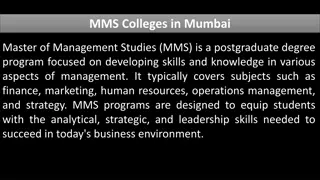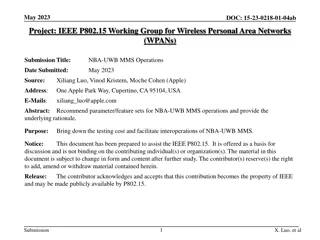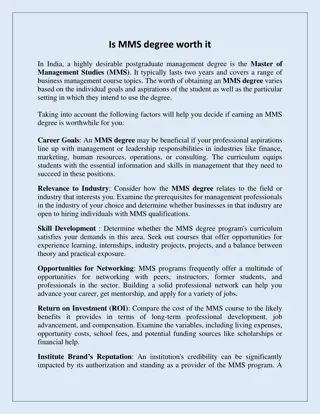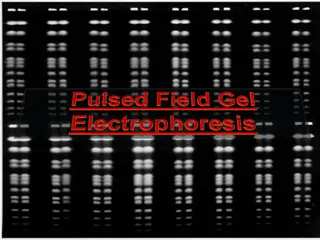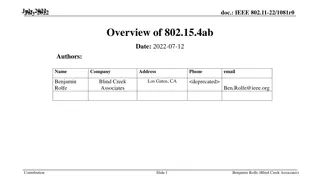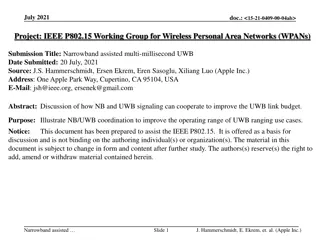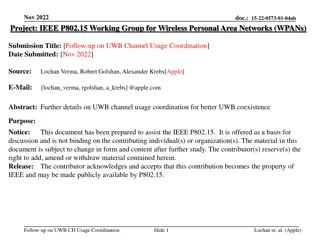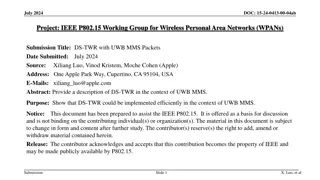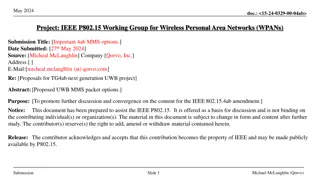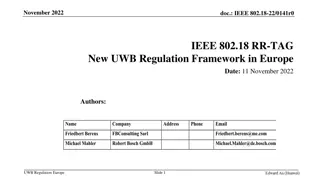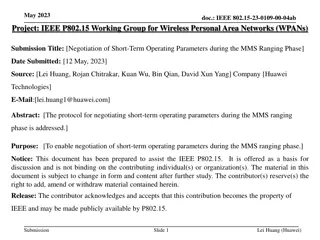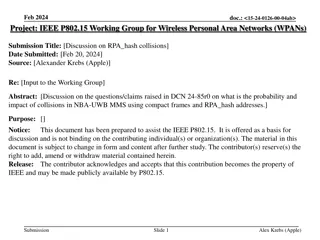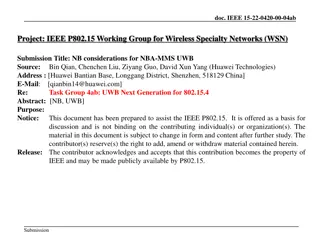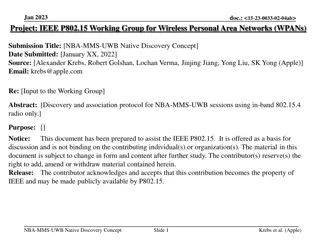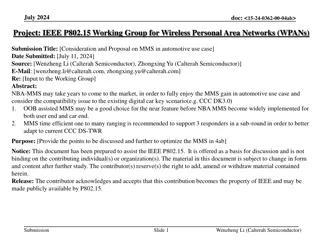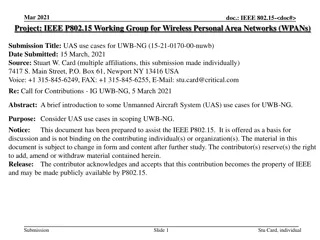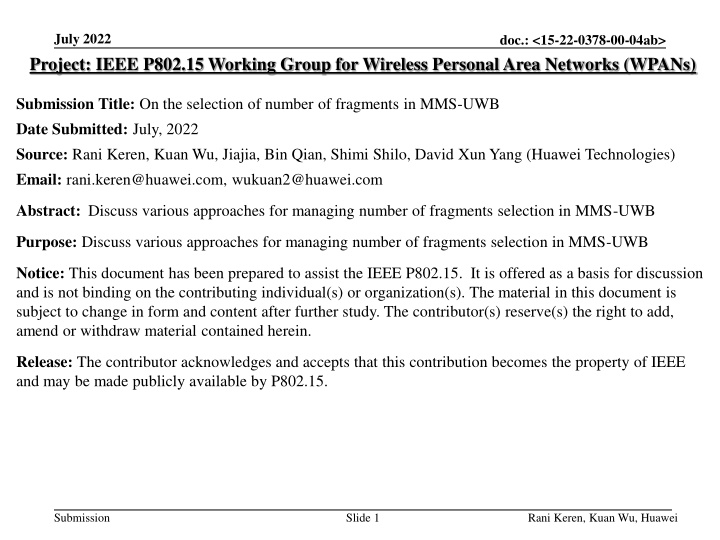
Selection of Fragments in MMS-UWB: Approaches and Discussion
Explore various approaches for managing the selection of the number of fragments in MMS-UWB, focusing on high throughput data use cases, interference mitigation, coexistence improvement, and more. The document discusses the NBA-UWB message sequence and phases involved in UWB MMS ranging, emphasizing the initiator's role in selecting the number of fragments during initialization.
Download Presentation

Please find below an Image/Link to download the presentation.
The content on the website is provided AS IS for your information and personal use only. It may not be sold, licensed, or shared on other websites without obtaining consent from the author. If you encounter any issues during the download, it is possible that the publisher has removed the file from their server.
You are allowed to download the files provided on this website for personal or commercial use, subject to the condition that they are used lawfully. All files are the property of their respective owners.
The content on the website is provided AS IS for your information and personal use only. It may not be sold, licensed, or shared on other websites without obtaining consent from the author.
E N D
Presentation Transcript
July 2022 Project: IEEE P802.15 Working Group for Wireless Personal Area Networks (WPANs) doc.: <15-22-0378-00-04ab> Submission Title: On the selection of number of fragments in MMS-UWB Date Submitted: July, 2022 Source: Rani Keren, Kuan Wu, Jiajia, Bin Qian, Shimi Shilo, David Xun Yang (Huawei Technologies) Email: rani.keren@huawei.com, wukuan2@huawei.com Abstract: Discuss various approaches for managing number of fragments selection in MMS-UWB Purpose: Discuss various approaches for managing number of fragments selection in MMS-UWB Notice: This document has been prepared to assist the IEEE P802.15. It is offered as a basis for discussion and is not binding on the contributing individual(s) or organization(s). The material in this document is subject to change in form and content after further study. The contributor(s) reserve(s) the right to add, amend or withdraw material contained herein. Release: The contributor acknowledges and accepts that this contribution becomes the property of IEEE and may be made publicly available by P802.15. Submission Slide 1 Rani Keren, Kuan Wu, Huawei
July 2022 doc.: <15-22-0378-00-04ab> PAR Objective Proposed Solution (how addressed) Safeguards so that the high throughput data use cases will not cause significant disruption to low duty-cycle ranging use cases Interference mitigation techniques to support higher density and higher traffic use cases Other coexistence improvement Backward compatibility with enhanced ranging capable devices (ERDEVs) Improved link budget and/or reduced air-time Discussion on MMS UWB ranging for extended range Additional channels and operating frequencies Improvements to accuracy / precision / reliability and interoperability for high-integrity ranging Reduced complexity and power consumption Hybrid operation with narrowband signaling to assist UWB Discussion on NBA UWB ranging sequence messages Enhanced native discovery and connection setup mechanisms Sensing capabilities to support presence detection and environment mapping Low-power low-latency streaming Higher data-rate streaming allowing at least 50 Mbit/s of throughput Support for peer-to-peer, peer-to-multi-peer, and station-to- infrastructure protocols Infrastructure synchronization mechanisms Submission Slide 2 Rani Keren, Kuan Wu, Huawei
July 2022 doc.: <15-22-0378-00-04ab> Introduction NBA-UWB message sequence has been discussed in [1]. Initiator NB Preamble UWB UWB 2 0 1 NB NB UWB UWB T(ms) Responder NB UWB second fragment UWB first fragment Measurement report synchronization messages Two messages in each slot for SS-TWR: Two fragments The NBA-UWB sequence may include three phases Initialization phase: NB message exchange for synchronization, configuration, etc. UWB MMS ranging measurement phase Measurement report phase In the initialization phase, the number of fragments for UWB MMS measurement phase should be selected by the initiator and notified to the responder(s). The selection process hasn t been discussed in details yet, but was mentioned by [1] Suggests that decision on number of fragments can be based on link channel conditions by monitoring receive power level of the NB sync messages. [1] 15-22-0266-00-04ab-discussion-on-nb-assisted-uwb-message-sequence-and-synchronization (May 12, 2022) , Pooria Pakrooh et al Submission Slide 3 Rani Keren, Kuan Wu, Huawei
July 2022 doc.: <15-22-0378-00-04ab> Number of MMS fragments selection The basic trade-off: More fragments -> reduced fragment duration -> increased fragment power boost -> increased range. On the other hand: more fragments -> increased overall transmit duration -> increased transmit latency. From link level perspective, the selection has similar considerations as in rate/link adaptation. Rate/link adaptation strives to minimize packet transmit duration for the purpose of efficient network throughput, while preserving receiver reliability. However, since in the MMS case, the net transmit duration by a single transmitter is independent of number of fragments, an efficient interlacing of multiple transmitters may allow increasing number of fragments without compromising network throughput. Link Data Rate Number of Fragments Number of Fragments Failed reception Failed reception Channel Capability Channel Capability Channel Capability Optimal Rate 3 fragments MMS 3 fragments MMS 6 fragments MMS Time Time Time MMS Transmission Continuous Transmission MMS interlaced Transmission Submission Slide 4 Rani Keren, Kuan Wu, Huawei
July 2022 doc.: <15-22-0378-00-04ab> Number of MMS fragments selection We identify two approaches for number of fragments selection: Approach 1 - Dynamic selection based on channel conditions: Minimize the duration of MMS transmission while preserving the receiver ranging processing reliability Motivated by airtime saving in favor of additional ranging applications. Requires channel conditions probing (To be discussed in following slides) Approach 2 - Fixed selection preconfigured to the largest number of fragments within the range defined for the dynamic selection approach. Motivated by implementation simplicity, eliminating the need for channel conditions probing, a selection feature and its corresponding signaling. May provide increased robustness in case of rapid changes in channel conditions by eliminating the need for channel tracking. Network throughput may be optimized by interlacing additional ranging applications within the same MMS procedure. Power back-off may be employed on MMS transmission towards short range devices. Slide 5 Submission Rani Keren, Kuan Wu, Huawei
July 2022 doc.: <15-22-0378-00-04ab> UWB channel probing using NB signal (Approach 1) An example comparison of PDF s of signal level between UWB and NB signals in an indoor multipath environment [2] shows that inferring the UWB signal level from a given NB signal level is expected to have low reliability due to the NB multipath fading effect. Therefore, direct UWB channel probing is required. [2] RECOMMENDATION ITU-R SM.1755-0, Characteristics of ultra-wideband technology, 2006 Submission Slide 6 Rani Keren, Kuan Wu, Huawei
July 2022 UWB channel probing using UWB signal (Approach 1) We propose two independent functions that can support the selection of number of fragments based on an on-going probing of the UWB signal. The two functions are complementary and can support a fast and efficient selection: A: Number of fragments in measurement phase is determined based on newly defined probing UWB signals in the preceding initialization phase. Useful for initial selection at the beginning of a ranging session. Also useful for robust channel tracking across ranging rounds in scenarios with fast channel changes. Introduces some probing overhead. B: Number of fragments in measurement phase is determined based on probing UWB signals in measurement phase of previous round Useful for updating the selection across ranging rounds for tracking slow channel changes. No probing overhead. doc.: <15-22-0378-00-04ab> Submission Slide 7 Rani Keren, Kuan Wu, Huawei
July 2022 doc.: <15-22-0378-00-04ab> UWB channel probing initialization phase (Approach 1 Function A) Combine bi-directional UWB probing signals within initialization phase: Responder analyzes initiator s UWB probing signal and reports back the calculated link margin using NB message #2. Initiator analyzes responder s UWB probing signal, selects number of fragments for the MMS measurement phase and announces it to responder using NB message #3. UWB probing signal may be formed by shortest fragment with highest power boost for guaranteed receiver processing reliability. Submission Slide 8 Rani Keren, Kuan Wu, Huawei
July 2022 UWB channel probing measurement phase (Approach 1 Function B) Bi-directional UWB channel probing is performed during measurement phase and a resulting update of number of fragments is applied in the following round. Responder reports the link margin during report phase NB message. doc.: <15-22-0378-00-04ab> (a) Ranging round k, before updating, 4 fragments in each direction (b) Ranging round k+1, after updating, 2 fragments in each direction Submission Slide 9 Rani Keren, Kuan Wu, Huawei
July 2022 doc.: <15-22-0378-00-04ab> Summary Two approaches have been suggested with respect to MMS number of fragments selection: Dynamic selection based on channel conditions probing. Fixed selection based on a pre-configuration. For supporting a dynamic selection applied to a given ranging round, channel probing can be based on either: Additional UWB probing signals during initialization phase of the given ranging round. UWB signals during ranging measurement phase of previous rounds. Submission Slide 10 Rani Keren, Kuan Wu, Huawei

